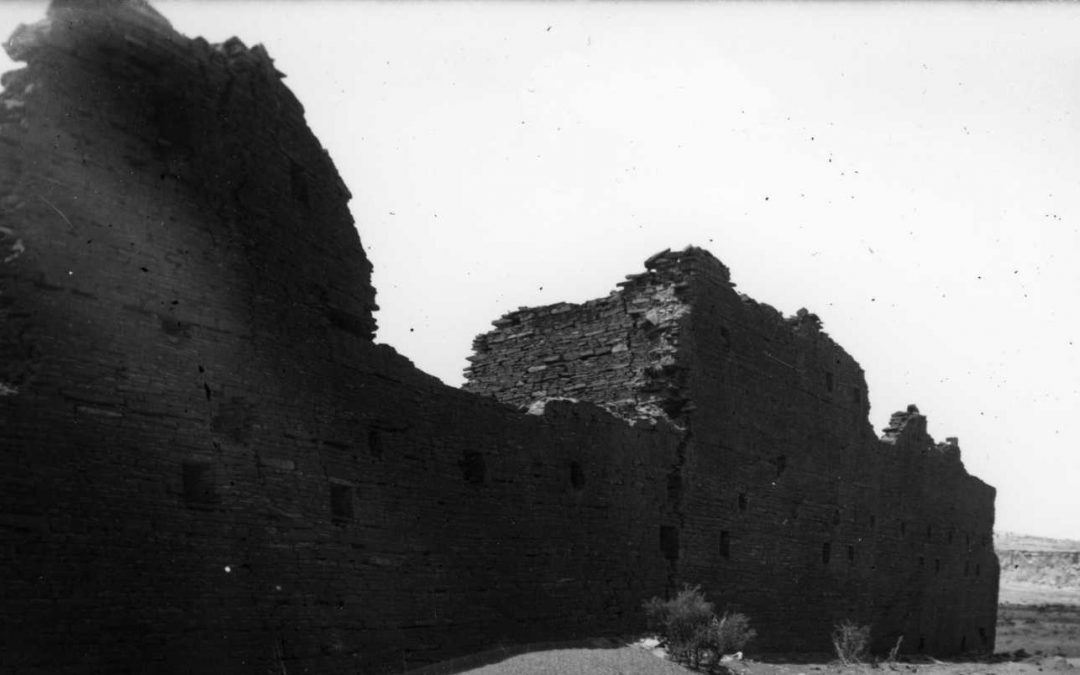After more than a century of research, we have gathered an astounding amount of information about Chaco Canyon and about the Ancestral Puebloan farmers who inhabited this place. We know, to the year, when trees were harvested to build great house roofs and floors. We can pick up a potsherd and know, within a 50-year window, when it was made (and sometimes where it was made). We know how the local precipitation changed from year to year, and we can calculate the ways in which this affected corn crop yields. We know that individuals interred in Pueblo Bonito were better nourished than those buried in small house sites. We know that corn, pottery, wood, and lithic materials were carried to Chaco from the Chuska Mountains, 75 km to the west. We know that feasts were held at Pueblo Alto and ritual paraphernalia was cached at Pueblo Bonito and Chetro Ketl. But we still have more questions than we have answers.
From excavations of Chaco in the early twentieth century to the latest research on cosmology, monumental architecture, and long-distance trade, SAR has supported scholars who wish to understand and protect this unique place—and shared their findings with other researchers and the public.
Patricia Crown, 2019–2020 Weatherhead fellow, is now exploring the connections among drinking practices and politics at Chaco. “SAR has a history of publishing some of the most informative and provocative studies of Chaco Canyon,” she says. “Even volumes seemingly on other topics (for example, the 2008 Memory Work volume edited by Mills and Walker) contain writings on Chaco that are a critical part of the canon. I use the SAR Chaco volumes in teaching graduate and undergraduate courses, as well as in my research. They chronicle the changing views of the canyon and its residents over the last century, covering a range of issues as basic as what Chaco houses looked like, how women and men spent their time, or what people ate—all the way to more esoteric topics such as ties to Mesoamerica, types of inalienable objects, or forms of leadership.”

Photos: Pueblo Bonito, Chaco Canyon, by Kenneth Chapman, 1902. SAR Archives AC02_769d (top) and AC02_769f (above).
Below you’ll find a list of SAR Press books about Chaco, along with a few others on related subjects. “Chaco certainly was phenomenal,” writes David Grant Noble in his preface to In Search of Chaco. “In the American Southwest, there was nothing else like it.” Like Van Dyke, Noble says that “the unknown still far outweighs the known” in research on Chaco. “In that sense, perhaps Chaco is a metaphor for our search for knowledge—the closer we get to it, the more elusive it becomes.”

The Archaeology of Chaco Canyon: An Eleventh-Century Pueblo Regional Center
Stephen H. Lekson (editor, 2006)
The contributors address central archaeological themes—environment, production, architecture, politics, society—placing Chaco in its time and region and considering what came before and after its heyday.

The Chaco Experience: Landscape and Ideology at the Center Place
Ruth M. Van Dyke (2008)
In her contribution to the Resident Scholar series, Van Dyke emphasizes the experience of moving through the landscape to illuminate Chacoan beliefs and social relationships.

Chaco & Hohokam: Prehistoric Regional Systems in the American Southwest
Patricia L. Crown and W. James Judge (editors, 1991)
Synthesizing data and current thought about the regional systems of the Chacoans and the Hohokam, eleven archaeologists examine settlement patterns, subsistence economy, social organization, and trade, shedding new light on two of the most sophisticated cultures of the prehistoric Southwest.

In Search of Chaco: New Approaches to an Archaeological Enigma
David Grant Noble (editor, 2004)
This completely updated edition features seventeen original essays; scores of photographs, maps, and site plans; and the perspectives of archaeologists, historians, and Native American thinkers, who consider the rise of great houses, agricultural life, sacred geography and astronomy, indigenous knowledge about Chaco, and its place in the wider world of archaeology.
You may also want to consider
- Aztec, Salmon, and the Puebloan Heartland of the Middle San Juan, edited by Paul F. Reed and Gary M. Brown, 2018
- A History of the Ancient Southwest, Stephen H. Lekson, 2009
- The Mesa Verde World: Explorations in Ancestral Pueblo Archaeology, edited by David Grant Noble, 2006
- Puebloan Societies: Homology and Heterogeneity in Time and Space, edited by Peter M. Whiteley, 2018
- A Pueblo Social History: Kinship, Sodality, and Community in the Northern Southwest, John A. Ware, 2014
Find out more about SAR Press and order any of our books on Chaco.
SAR has been publishing scholarship of the highest caliber for over one hundred years.

